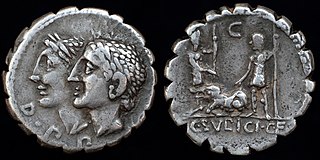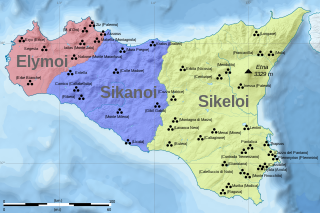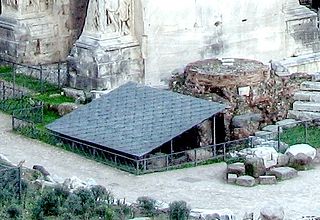
In Roman religion, Angerona or Angeronia was an old Roman goddess, whose name and functions are variously explained. She is sometimes identified with the goddess Feronia.

In ancient Roman religion, the Di Penates or Penates were among the dii familiares, or household deities, invoked most often in domestic rituals. When the family had a meal, they threw a bit into the fire on the hearth for the Penates. They were thus associated with Vesta, the Lares, and the Genius of the pater familias in the "little universe" of the domus.
In ancient Roman religion, Sancus was a god of trust, honesty, and oaths. His cult, one of the most ancient amongst the Romans, probably derived from Umbrian influences. Cato and Silius Italicus wrote that Sancus was a Sabine god and father of the eponymous Sabine hero Sabus. He is thus sometimes considered a founder-deity.

The Sabines (, SAY-bynes,, SAB-eyens; Latin: Sabini; Italian: Sabini were an Italic people who lived in the central Apennine Mountains of the ancient Italian Peninsula, also inhabiting Latium north of the Anio before the founding of Rome.

Saturnalia is an ancient Roman festival and holiday in honour of the god Saturn, held on 17 December of the Julian calendar and later expanded with festivities through 19 December. By the 1st century B.C., the celebration had been extended through 23 December, for a total of seven days of festivities. The holiday was celebrated with a sacrifice at the Temple of Saturn, in the Roman Forum, and a public banquet, followed by private gift-giving, continual partying, and a carnival atmosphere that overturned Roman social norms: gambling was permitted, and masters provided table service for their slaves as it was seen as a time of liberty for both slaves and freedmen alike. A common custom was the election of a "King of the Saturnalia", who gave orders to people, which were followed and presided over the merrymaking. The gifts exchanged were usually gag gifts or small figurines made of wax or pottery known as sigillaria. The poet Catullus called it "the best of days".

In ancient Roman religion and myth, Janus is the god of beginnings, gates, transitions, time, duality, doorways, passages, frames, and endings. He is usually depicted as having two faces. The month of January is named for Janus (Ianuarius). According to ancient Roman farmers' almanacs, Juno was mistaken as the tutelary deity of the month of January, but Juno is the tutelary deity of the month of June.

Marcus Terentius Varro was a Roman polymath and a prolific author. He is regarded as ancient Rome's greatest scholar, and was described by Petrarch as "the third great light of Rome". He is sometimes called Varro Reatinus to distinguish him from his younger contemporary Varro Atacinus.

Juno was an ancient Roman goddess, the protector and special counsellor of the state. She was equated to Hera, queen of the gods in Greek mythology and a goddess of love and marriage. A daughter of Saturn and Ops, she was the sister and wife of Jupiter and the mother of Mars, Vulcan, Bellona, Lucina and Juventas. Like Hera, her sacred animal was the peacock. Her Etruscan counterpart was Uni, and she was said to also watch over the women of Rome. As the patron goddess of Rome and the Roman Empire, Juno was called Regina ("Queen") and was a member of the Capitoline Triad, centered on the Capitoline Hill in Rome, and also including Jupiter, and Minerva, goddess of wisdom.

The Lacus Curtius was a pit or pool in the ground in the Forum Romanum. The area where the Forum would later be built was originally likely a lake, as the area it was in is known to have been surrounded by brooks and marshes. One part of the area was never drained, but gradually became smaller until only a basin, known as the Lacus Curtius, was left. Its nature and significance in Rome's early history is uncertain, and several conflicting stories exist about its history.

The Sicani or Sicanians were one of three ancient peoples of Sicily present at the time of Phoenician and Greek colonization. The Sicani dwelt east of the Elymians and west of the Sicels, having, according to Diodorus Siculus, the boundary with the last in the ancient Himera river (Salso) after a series of battles between these tribes.

Aquae Cutiliae is an ancient Roman site situated on mineral springs known today as Terme di Cotilia or Terme di Vespasiano, near the modern Cittaducale, 9 miles east of Rieti in the Sabina region.

The Compitalia was an annual festival in ancient Roman religion held in honor of the Lares Compitales, household deities of the crossroads, to whom sacrifices were offered at the places where two or more ways met.

Vulcan is the god of fire including the fire of volcanoes, deserts, metalworking and the forge in ancient Roman religion and myth. He is often depicted with a blacksmith's hammer. The Vulcanalia was the annual festival held August 23 in his honor. His Greek counterpart is Hephaestus, the god of fire and smithery. In Etruscan religion, he is identified with Sethlans.
Statonia was an ancient Etruscan city whose location is unknown and disputed.

Saturn was a god in ancient Roman religion, and a character in Roman mythology. He was described as a god of time, generation, dissolution, abundance, wealth, agriculture, periodic renewal and liberation. Saturn's mythological reign was depicted as a Golden Age of abundance and peace. After the Roman conquest of Greece, he was conflated with the Greek Titan Cronus. Saturn's consort was his sister Ops, with whom he fathered Jupiter, Neptune, Pluto, Juno, Ceres and Vesta.

The Aborigines in Roman mythology are the oldest inhabitants of central Italy, connected in legendary history with Aeneas, Latinus and Evander. They were supposed to have descended from their mountain home near Reate upon Latium, where they expelled the Sicels and subsequently settled down as Latini under a King Latinus.

The Mother of the Lares has been identified with any of several minor Roman deities. She appears twice in the records of the Arval Brethren as Mater Larum, elsewhere as Mania and Larunda. Ovid calls her Lara, Muta and Tacita.
The Curia Calabra was a religious station or templum used for the ritual observation of the new moon in ancient Rome. Although its exact location is unclear, it was most likely a roofless enclosure in front of an augural hut (auguraculum), on the southwest flank of the Area Capitolina, the precinct of the Temple of Capitoline Jupiter. Servius identifies the Curia Calabra with a Casa Romuli on the Capitoline, but Macrobius implies that it was adjacent to the Casa.

The altar of Saturn is an archaic altar dedicated to the god Saturn. Constructed in the sixth century BCE, it continued to be used until the Roman Empire collapsed. It is located in front of the Temple of Saturn in the Roman Forum and its remains were uncovered by Rodolfo Lanciani in 1902.

















